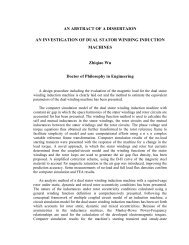CLIFFORD AND GRASSMANN HOPF ALGEBRAS VIA THE ...
CLIFFORD AND GRASSMANN HOPF ALGEBRAS VIA THE ...
CLIFFORD AND GRASSMANN HOPF ALGEBRAS VIA THE ...
You also want an ePaper? Increase the reach of your titles
YUMPU automatically turns print PDFs into web optimized ePapers that Google loves.
of tensor monoms. It is the multilinearity that guarantees that every tensor<br />
can be written as a linear combination of some tensor basis monoms (Hilbert<br />
basis theorem). The i-th place in a list of arguments of a tensor will be called<br />
the i-th slot.<br />
Acting on a tensor means:<br />
• Removing or grafting of terms from or into a tensor<br />
• Rearranging the tensor<br />
• Acting with operators on n-slots producing m-slots<br />
The first set of operations is given by peek and poke. They work as expected:<br />
peek takes as an argument a number of the slot which it intends to remove<br />
and returns a sequence of lists of the removed terms and the remaining tensor.<br />
Procedure poke needs three arguments: a tensor, a Graßmann multivector<br />
which will be put into the i-th place, and the slot number i.<br />
> f:=x->’peek’(x,2):x:=&t(e1,a*e2+b*e3,e3):f(x)=eval(f(x));<br />
peek(&t(e1 ,ae2 , e3 )+&t(e1 ,be3 , e3 ), 2) = ([a e2 , e1 &t e3 ], [b e3 , e1 &t e3 ])<br />
> g:=x-> ’poke’(x,e2,3):x:=&t(e1,a*e2+b*e3):g(x)=eval(g(x));<br />
poke((e1 &t a e2 )+(e1 &t b e3 ), e2 , 3) = &t(e1 ,ae2 , e2 ) + &t(e1 ,be3 , e2 )<br />
The second group of operations consists of switches –also called crossings or<br />
braids– which allow to reorder the tensors. In any CAS, it would be easy, say,<br />
to multiply the i-th and the j-th slots of a tensor and place the output into<br />
the k-th slot. However, mathematical reasons disallow such a brute method.<br />
If one demands that any reordering process be generated from the reordering<br />
rules of generators, one has to assume that a crossing is a natural transformation<br />
in a functorial sense and obeys coherence, see [12–14]. In fact these<br />
two conditions imply the quantum Yang Baxter equation which is discussed<br />
below. The Graßmann Hopf algebraic graded crossing and the ordinary switch<br />
(swap) of two elements fulfill these properties.<br />
The switch procedure swaps two adjacent tensor slots in a general tensor<br />
polynomial, while the graded switch gswitch respects the grading of the factors.<br />
Both functions take as a second argument i, the number of the tensor<br />
slot to act on, that is, to switch the i-th and the (i + 1)-st tensor entries.<br />
> f1:=x->’switch’(x,2):x:=&t(e1,e2,e3,e4):f1(x)=eval(f1(x));<br />
switch(&t(e1 , e2 , e3 , e4 ), 2) = &t(e1 , e3 , e2 , e4 )<br />
> f2:=x->’gswitch’(x,2):x:=&t(e1,e2,e3,e4):f2(x)=eval(f2(x));<br />
gswitch(&t(e1 , e2 , e3 , e4 ), 2) = −&t(e1 , e3 , e2 , e4 )<br />
6
















